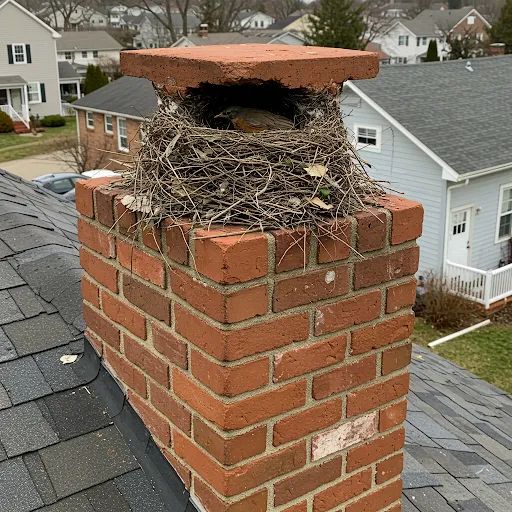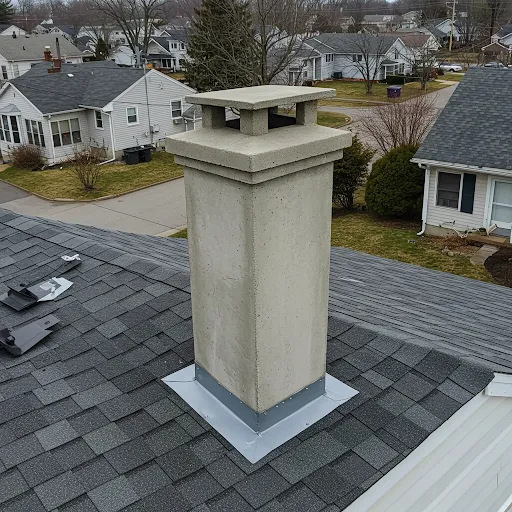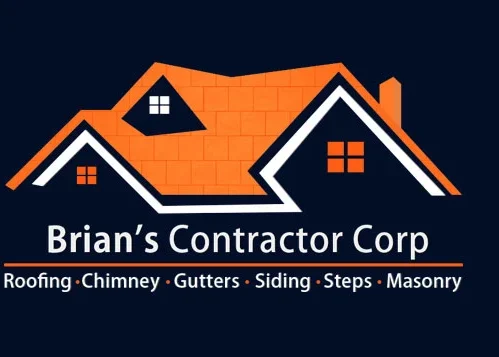
Chimneys are essential for keeping your home safe by venting smoke and gases from fireplaces, furnaces, and heating systems. But when chimneys get damaged, it can lead to some serious problems, like house fires, carbon monoxide leaks, and major structural damage. Understanding what causes chimney damage Baldwin homeowners often face is crucial to preventing these issues. Plus, a damaged chimney can hurt your home’s curb appeal and lower its value.
For homeowners in Baldwin, New York, chimney care is especially important due to the area’s unique weather. With cold winters, high humidity, and salty air from the nearby coast, chimneys face extra wear and tear. These environmental factors can lead to cracks, corrosion, and other damage over time.
In this blog, we’ll break down the most common causes of chimney damage in Baldwin. We’ll take a closer look at how the weather, the materials your chimney is made of, and regular maintenance can affect your chimney’s lifespan. By understanding these risks, you’ll be in a better position to protect your home and keep your chimney in top shape.
General Causes of Chimney Damage

Chimney deterioration in residential buildings results from a range of interconnected factors. Understanding these general causes provides a critical foundation for assessing specific circumstances, such as those in Baldwin, New York.
Poor Construction
Although less common, poor construction practices can introduce significant vulnerabilities into a chimney from the beginning. Using substandard materials, such as damaged bricks or defective masonry components, weakens the structure. Improper installation of key elements, like chimney liners, can lead to premature failures and increase exposure to damage.
Common construction flaws include:
- Inadequate Footings: Weak foundations can cause settling, leading to cracking and instability.
- Mismatched Flue Sizes: Incorrect flue dimensions relative to appliances can cause unsafe drafting and buildup of harmful byproducts.
- Unparged Smoke Chambers: Failing to smooth the interior of the smoke chamber leaves points of turbulence that accelerate deterioration.
- Missing or Improper Components: Skipping necessary prefabricated parts or cutting corners during construction can create critical weak spots.
These issues cause smoke leaks, speed up deterioration, and make your chimney vulnerable to environmental factors. Our guide on understanding a chimney helps you spot problems early – save thousands in repairs.
Lack of Maintenance
Regular maintenance is essential for the safe and long-term performance of a chimney. Common maintenance failures include:
- Infrequent Cleaning: Allowing creosote buildup not only increases the risk of chimney fires but can also corrode liners and masonry.
- Neglecting Repairs: Worn chimney caps, damaged flashing, and other compromised components expose the structure to water leaks and animal intrusion.
- Skipping Inspections: Without annual inspections, minor issues often escalate into costly repairs.
Neglect ultimately accelerates the effects of weather, usage, and environmental wear, shortening the chimney’s lifespan.
Weather Conditions
Exposure to harsh weather is a leading cause of chimney damage:
- Freeze-Thaw Cycles: Water infiltration followed by freezing temperatures causes expansion and cracking in masonry.
- Wind and Hail: High winds can dislodge chimney caps and flashing, while hail can crack crowns and stonework.
- Lightning: Though rare, lightning strikes can severely damage or shatter chimney masonry.
Chimneys constantly endure the stress of seasonal weather patterns, making weatherproofing and inspections crucial.
Water and Moisture
Water is one of the most destructive forces affecting chimneys:
- Masonry and Mortar Damage: Water infiltration deteriorates brick, stone, and mortar joints.
- Corrosion of Metal Components: Dampers, fireboxes, and metal flue liners are highly vulnerable to rust and corrosion.
- Mold and Structural Damage: Persistent moisture promotes mold growth and can lead to the rot of adjacent structural materials, impacting the home’s integrity.
Proper waterproofing and maintenance are essential to prevent moisture-related damage.
Natural Disasters
While less common, natural disasters can cause immediate and severe chimney damage:
- Earthquakes: Seismic activity can crack or collapse chimneys.
- Storm Damage: Falling trees or large branches, often during severe storms, can directly strike and damage chimneys.
In disaster-prone areas, reinforced construction and periodic evaluations are vital.
Animals
Wildlife often contributes to chimney damage:
- Nesting Animals: Birds, squirrels, and raccoons may build nests inside chimneys, blocking airflow and creating fire hazards.
- Structural Damage: Larger animals can physically damage masonry and chimney components while attempting to enter or build nests.
Installing chimney caps and screening can help deter animal intrusions.
Environmental Factors Contributing to Chimney Damage
Baldwin, New York, experiences a climate characterized by distinct seasons, with winters that bring freezing temperatures, and its location near the Atlantic Ocean introduces unique environmental stressors on residential chimneys.
The region’s weather patterns include average high temperatures reaching 80°F in the summer and lows dropping to 13°F in the winter. The mean temperature throughout the year is around 46°F, with an average annual precipitation of approximately 2.49 inches. Snowfall is common during the winter months, contributing to overall precipitation. These freezing temperatures are a significant factor in chimney deterioration, as they facilitate the damaging freeze-thaw cycle. When water penetrates the porous materials of a chimney, such as brick and mortar, and then freezes, it expands. This expansion creates internal pressure within the masonry, leading to cracks and spalling. As temperatures fluctuate above and below freezing, this cycle repeats, progressively weakening the chimney’s structure.
Baldwin’s coastal proximity to the Atlantic Ocean introduces the challenge of salt air. The salt carried in the air can deposit on chimney surfaces, particularly affecting metal components.
Chimney caps, flashing, and dampers, often made of metal, are susceptible to corrosion from this salt exposure, which can weaken their structural integrity and lead to failure. Furthermore, salt can also interact with the materials in masonry, contributing to the deterioration of mortar and the spalling of bricks over time.
The increased humidity typical of coastal areas like Baldwin can exacerbate these issues. Higher humidity levels mean more moisture in the air, which can prolong the contact of salt with chimney materials, accelerating corrosion. This combination of salt air and humidity creates a particularly challenging environment for maintaining the integrity of residential chimneys in Baldwin.
Month | High Temp (°F) | Low Temp (°F) | Mean Temp (°F) | Precipitation (“) | Humidity (%) | Dew Point (°F) | Wind (mph) |
January | 30 | 13 | 21 | 1.69 | 70 | 13 | 13 |
February | 33 | 14 | 24 | 1.28 | 65 | 13 | 14 |
March | 41 | 22 | 32 | 1.69 | 63 | 20 | 14 |
April | 55 | 33 | 44 | 2.47 | 60 | 29 | 15 |
May | 68 | 45 | 56 | 2.84 | 64 | 42 | 13 |
June | 76 | 54 | 65 | 3.23 | 70 | 53 | 12 |
July | 80 | 59 | 69 | 3.76 | 73 | 59 | 10 |
August | 78 | 57 | 68 | 3.19 | 74 | 58 | 10 |
September | 71 | 50 | 60 | 2.83 | 75 | 51 | 11 |
October | 58 | 39 | 49 | 2.99 | 72 | 39 | 12 |
November | 46 | 29 | 38 | 2.04 | 70 | 28 | 13 |
December | 36 | 20 | 28 | 1.88 | 73 | 20 | 13 |
Annual | 80 | 13 | 46 | 2.49 | 69 | 35 | 13 |
Typical Chimney Construction Materials and Associated Damage
 Brick Chimneys
Brick Chimneys
- Common in residential construction, with firebrick lining the firebox.
- Vulnerable mortar joints can crack, crumble, or fall away due to freeze-thaw cycles and water penetration.
- Spalling occurs when brick surfaces flake, chip, or break off from moisture absorption and freezing.
- Lower-quality bricks (higher porosity) and exposure to Baldwin’s coastal salt air accelerate deterioration.
Stone Chimneys
- More durable than brick but still susceptible to weathering, water penetration, and freeze-thaw damage.
- Mortar joints require regular repointing to maintain structural integrity.
- Long-term exposure to coastal salt air can corrode mortar and weaken the structure.
Concrete Chimneys (Chimney Crowns)
- Commonly used for chimney crowns at the top of masonry chimneys.
- Prone to cracking from weather extremes and house settling.
- Cracks allow water intrusion, leading to internal masonry damage and flue liner deterioration.
- Coastal salt air accelerates concrete cracking, spalling, and weakening.
Flue Liners
- Materials include clay, terra cotta, cast-in-place cement, and stainless steel.
- Clay and terra cotta liners can crack from moisture, creosote buildup, and acidic gases.
- Stainless steel liners resist corrosion and high temperatures, ideal for Baldwin’s coastal environment.
Impact of Chimney Usage and Maintenance
Usage Factors
- Frequent wood burning leads to creosote buildup, a flammable and acidic substance.
- Combustion byproducts can corrode the flue liner and masonry.
- Repeated heating and cooling stress the chimney structure, potentially causing cracks.
Importance of Maintenance
- Annual professional inspections detect early-stage problems, allowing timely repairs.
- Regular chimney cleanings remove creosote and debris, reducing fire and ventilation risks.
- Prompt repairs to the crown, cap, or flashing prevent water intrusion and further damage.
- Waterproofing treatments protect masonry from moisture damage, vital in Baldwin’s humid, coastal climate.
- Installing a chimney cap prevents water, debris, and animal entry, addressing multiple damage risks.
Consequences of Neglect
- Lack of maintenance accelerates deterioration.
- Increases the risk of expensive repairs, chimney fires, and carbon monoxide leaks.
Chimney Deterioration
Environmental Factors
- Water penetration through cracks, mortar joints, crowns, and flashing leads to rust, flue liner deterioration, mold growth, and interior home leaks.
- Freeze-thaw cycles cause trapped water to expand and crack masonry, leading to spalling and weakening of the chimney.
Combustion Byproducts
- Burning wood produces creosote, which corrodes the flue liner and damages masonry.
- Burning fossil fuels (gas, oil) creates acidic condensation that corrodes metal components and accelerates chimney failure.
Common Chimney Issues Encountered by Repair Services
Masonry Repairs
- Frequent need for brick pointing (repairing mortar joints) and addressing spalling bricks.
- Deterioration is largely due to the coastal environment and freeze-thaw cycles.
Chimney Leaks and Water Damage
- Water intrusion is a major cause of chimney deterioration, especially given Baldwin’s coastal climate and precipitation levels.
Damage to Chimney Caps and Crowns
- Chimney caps and crowns, which protect against water and debris, are prone to weather-related damage and often require maintenance or replacement.
Flue Liner Repairs and Replacements
- Flue liners suffer from internal damage caused by creosote buildup, corrosive gases, thermal stress, or water penetration, making repairs and replacements common.
Chimney Cleaning and Creosote Removal
- Regular creosote removal is a standard, essential service to reduce the risk of chimney fires.
Animal Removal and Blockage Clearing
- Services frequently address issues with animals nesting in chimneys and other blockages that obstruct the flue.
Overall Patterns
- Homeowners commonly face masonry deterioration, water damage, component failures (caps, crowns, liners), creosote buildup, and animal-related problems.
These issues highlight Baldwin’s critical need for proactive chimney maintenance and timely repairs.
Recommendations for Preventing and Addressing Chimney Damage
Regular Inspections and Maintenance
- Schedule an annual professional chimney inspection to identify potential problems early.
- Clean the chimney at least once a year to remove flammable creosote and obstructions.
- Promptly address any issues found during inspections to prevent more serious damage and costly repairs.
Water Protection
- Ensure the chimney crown is in good repair and properly sealed to prevent water intrusion.
- Repair or replace damaged chimney caps and flashing to maintain a watertight seal.
- Apply a breathable waterproofing sealant to exterior masonry to prevent water absorption while allowing moisture vapor to escape.
Material Considerations
- Use stainless steel for flue liner replacements to maximize durability and corrosion resistance, especially in coastal areas like Baldwin.
- Choose high-quality bricks and mortar appropriate for chimney construction for any masonry repairs to ensure long-lasting results.
Environmental Factors
- Remove vegetation, such as ivy or climbing vines, from chimney structures to prevent moisture retention and masonry damage.
- Trim back overhanging tree branches to avoid physical damage and prevent debris from falling into the chimney.
Usage Practices
- Burn only seasoned, dry firewood to minimize creosote buildup and reduce the risk of fire and corrosion, following best practices from the U.S. Department of Energy.
- Ensure proper ventilation when using fireplaces or heating systems to expel combustion byproducts efficiently.
Addressing Existing Damage
- Contact qualified and certified chimney repair professionals promptly when signs of damage are noticed. Check our guide to chimney to know what questions to ask – smart homeowners always come prepared!
- Obtain multiple quotes and verify contractor credentials and reputation before proceeding with repair work.
Ensuring the Safety and Durability of Your Chimney
In conclusion, chimney damage in Baldwin, New York, is influenced by a combination of general factors affecting residential chimneys and specific environmental conditions prevalent in the region.
These environmental stressors, along with the vulnerabilities of common construction materials like brick, stone, and concrete, and compounded by poor construction, lack of maintenance, and damage from vegetation or animals, create a complex risk landscape.
Local chimney repair professionals regularly report issues ranging from masonry cracks and water damage to blockages caused by neglect.
To stay ahead of these challenges, proactive maintenance is crucial. Regular chimney inspections, annual chimney sweeps, comprehensive chimney services, and timely chimney restoration work—including chimney rebuilds when necessary—combined with preventative measures such as waterproofing and the installation of chimney caps, can significantly reduce the risk of structural damage, fires, and carbon monoxide leaks.
Homeowners in Baldwin are encouraged to take action before small problems escalate into costly repairs.
Don’t wait until it’s too late—schedule your chimney inspection or repair today. Call us at 929-570-7620 to speak with a local expert and get the reliable chimney care your home deserves.


